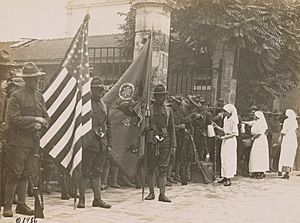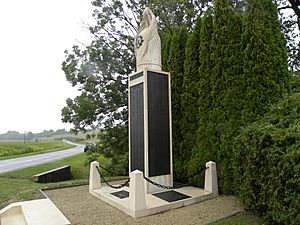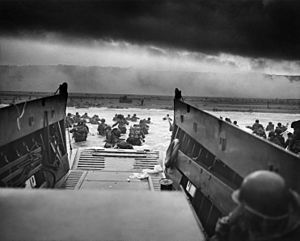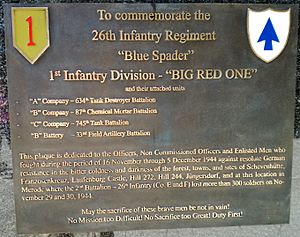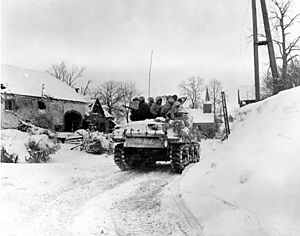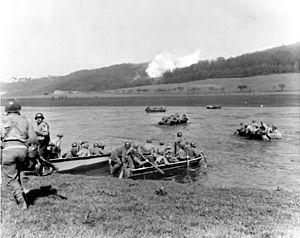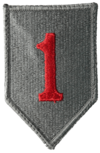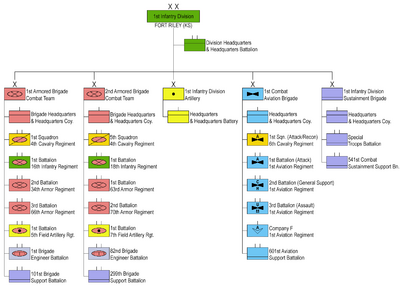1st Infantry Division (United States) facts for kids
Quick facts for kids 1st Infantry Division |
|
|---|---|

Insignia of the 1st Infantry Division
|
|
| Active | 24 May 1917 - present |
| Country | United States |
| Branch | United States Army |
| Type | Combined arms |
| Size | Division |
| Part of | III Armored Corps |
| Garrison/HQ | Fort Riley, Kansas |
| Nickname(s) | "The Big Red One" (abbreviated "BRO") "The Bloody First" |
| Motto(s) | No Mission Too Difficult. No Sacrifice Too Great. Duty First! |
| March | "The Big Red One Song" |
| Mascot(s) | Rags |
| Engagements |
|
| Website | |
| Commanders | |
| Commanding General | Major General John V. Meyer III |
| Deputy Commanding General | Brigadier General Niave F. Knell |
| Command Sergeant Major | Command Sergeant Major Christopher L. Mullinax |
| Notable commanders |
List of commanders |
| Insignia | |
| Subdued shoulder sleeve insignia, worn on ACU | 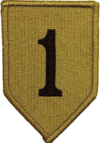 |
| Combat Service Identification Badge |  |
| Distinctive unit insignia | 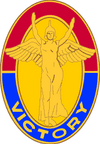 |
| Flag |  |
The 1st Infantry Division is a special military group in the United States Army. It's the oldest division that has been serving without a break since it was formed in 1917 during World War I. People often call it "The Big Red One" because of its unique shoulder patch. It's also known as "The Fighting First." This division is currently based at Fort Riley, Kansas.
Contents
The Big Red One in World War I
A few weeks after the United States joined World War I, the First Expeditionary Division was created on May 24, 1917. It was later named the 1st Infantry Division. Soldiers from different parts of the U.S. Army came together to form this new group.
The first units sailed from New York and New Jersey on June 14, 1917. The rest of the division followed, arriving in France and England. After some training, they were ready for action.
On July 4, 1917, soldiers from the 1st Division marched through Paris. This was to boost the spirits of the French people. A famous story says that Captain Charles E. Stanton declared, "Lafayette, nous sommes ici!" (meaning "Lafayette, we are here!"). This showed America's commitment to helping France.
On October 23, the 1st Division fired the first American shell of the war. Two days later, some of its soldiers became the first American casualties.
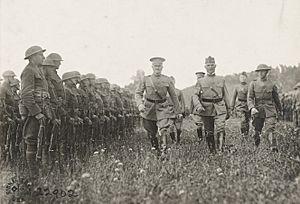
By April 1918, German forces were close to Paris. The 1st Division moved to the Picardy Sector to help the tired French army. They attacked the village of Cantigny, capturing it in just 45 minutes. This was the first American victory of the war.
The 1st Division also helped capture Soissons in July 1918. This victory was tough, with many soldiers killed or wounded. They also took part in the first American offensive of the war, helping to clear the Saint-Mihiel area in September 1918.
The last major battle of World War I for the division was in the Meuse-Argonne Forest. The division advanced seven kilometers and defeated eight German divisions. This success was largely due to George C. Marshall.
The war ended on November 11, 1918. The 1st Division was at Sedan, the farthest American troops went. They were also the first to cross the Rhine River into Germany. By the end of the war, the division had suffered many casualties. Five of its soldiers received the Medal of Honor.
The division had a dog mascot named Rags. Rags was a mixed-breed terrier who became famous as a war dog. He saved many lives in the Argonne Campaign by delivering an important message, even after being bombed and gassed.
Between the World Wars
After World War I, the 1st Division returned to the U.S. in September 1919. Its headquarters were set up in Brooklyn.
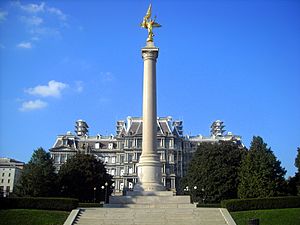
The division was reorganized several times to prepare for future conflicts. By 1940, it had three infantry regiments and other support units. Its strength grew to over 15,000 soldiers.
The Big Red One in World War II
After Germany invaded Poland, starting World War II in Europe, the 1st Infantry Division moved to Fort Benning, Georgia. It trained there and in Louisiana.
On December 7, 1941, Japan attacked Pearl Harbor. Four days later, Germany declared war on the United States. This brought the U.S. into the war. The 1st Division quickly moved to Florida for more training and new equipment. It was officially renamed the 1st Infantry Division on May 15, 1942.
The division, led by Major General Terry Allen, left New York on August 1, 1942. It arrived in England and then departed for North Africa on October 22, 1942.
As part of Operation Torch, the division landed in Oran, Algeria, on November 8, 1942. This was the Allied invasion of French North Africa. The division fought in many battles, including Kasserine Pass and El Guettar. They helped secure Tunisia by May 1943, leading to the surrender of nearly 250,000 Axis soldiers.
In July 1943, the division took part in Operation Husky, the Allied invasion of Sicily. They faced tough fighting against Italian and German tanks at the Battle of Gela. They also fought in the mountains, including the difficult Battle of Troina. After Sicily, the division returned to England to prepare for the invasion of Normandy.
On D-Day, June 6, 1944, parts of the 1st Infantry Division were among the first troops to attack German defenses on Omaha Beach. They faced heavy fire, with some units losing 30% of their soldiers in the first hour. Despite this, they secured their beachhead by the end of the day.
The division then pushed across France. They took many prisoners during the Battle of the Mons Pocket. In September, they reached the German border at Aachen. They laid siege to Aachen and captured the city on October 21, 1944.
After six months of continuous fighting, the division rested in December 1944. But when Germany launched the Battle of the Bulge on December 16, the division quickly moved to the Ardennes front. They fought from December 17, 1944, to January 28, 1945, helping to stop the German attack.
The division then broke through the Siegfried Line again. They fought across the Ruhr River on February 23, 1945, and drove to the Rhine River. They crossed at the Remagen bridgehead on March 15–16. The division helped surround the Ruhr Pocket, captured Paderborn, and pushed through the Harz Mountains. They were fighting in Czechoslovakia when the war in Europe ended. Sixteen members of the division received the Medal of Honor during World War II.
The Cold War Era
During the Korean War, the Big Red One was stationed in Germany. Their job was to help prevent the Soviet Union from expanding into Europe. They also guarded the Nuremberg War Crimes Trials. In 1955, the division moved to Fort Riley, Kansas.
In the 1960s, parts of the 1st Infantry Division rotated to West Berlin, Germany. This was during a time of international tension caused by the building of the Berlin Wall. These deployments put the Big Red One soldiers face-to-face with communist forces.
The Big Red One in Vietnam
The division fought in the Vietnam War from 1965 to 1970. They arrived in July 1965 and began combat operations within two weeks. They participated in many major operations, including Operation Hump, Operation Crimp II, and Operation Attleboro.
In 1967, the division was involved in Operation Cedar Falls and Operation Junction City. They also faced heavy fighting in battles like Xom Bo II and Ong Thanh.
The division played a role in the Tet Offensive of 1968, securing the large Tan Son Nhut Air Base. Major General Keith L. Ware took command in March but was killed in action in September when his helicopter was shot down.
In 1969, the Big Red One focused on "Progress Together" operations. These aimed to help South Vietnamese forces take a more active role in combat. The division officially left South Vietnam on April 7, 1970, returning to Fort Riley. Eleven members of the division received the Medal of Honor during the Vietnam War.
After the Cold War
The First Gulf War
The 1st Infantry Division took part in Operation Desert Storm. They played a big role in the Battle of Norfolk. They were responsible for breaking through Iraqi defenses, capturing many prisoners, and destroying enemy vehicles. The division advanced over 260 kilometers in 100 hours, engaging eleven Iraqi divisions.
The division's artillery was very effective, destroying many enemy tanks, vehicles, and artillery pieces. By February 28, 1991, the division had blocked Iraqi retreat routes. They then secured the town of Safwan, Iraq, and its airfield, where the Iraqis later signed the surrender agreement.
A unique tactic used was the "bulldozer assault." The 1st and 2nd Brigades used special equipment on tanks to bury Iraqi soldiers defending the "Saddam Line." Thousands of Iraqi soldiers surrendered, but some were reportedly buried alive.
In 1996, the division moved to Würzburg, Germany. They stayed there until 2006, when they moved back to Fort Riley, Kansas.
Missions in the Balkans
Parts of the division deployed to Bosnia and Kosovo in the 1990s. They were part of international peacekeeping missions like IFOR and SFOR. During the Kosovo War, three soldiers were captured by Serbian forces but were later released.
Iraq 2003 and 2004
In January 2003, the division headquarters went to Turkey. Their mission was to help move the 4th Infantry Division into Northern Iraq. However, Turkey did not allow U.S. ground forces to pass, so the division returned to Germany.
Later, in January 2004, the 1st Infantry Division deployed from Germany to Iraq. They took over from the 4th Infantry Division in several provinces. The division headquarters was at Forward Operating Base Danger in Tikrit. They conducted operations to fight insurgents, train Iraqi security forces, and help with elections. They were involved in major combat in places like Baqubah and Fallujah. In February 2005, the division returned to Germany.
Back to the US and More Deployments
In July 2006, the division moved from Germany back to Fort Riley, Kansas. Only the 2nd Brigade stayed in Germany for a while longer.
From 2006 to 2007, the 2nd Brigade Combat Team deployed to Iraq. They helped reduce violence in Baghdad. During this deployment, 61 soldiers from the brigade were killed.
From 2008 to 2009, the 3rd Brigade, "Duke," deployed to Eastern Afghanistan. They faced intense combat daily and were involved in the Battle of Bari Alai. They focused on protecting towns and helping the local economy. The brigade returned to Fort Hood, Texas, after a year of combat with many firefights and casualties.
The 2nd Heavy Brigade Combat Team also deployed to northwest Baghdad from 2008 to 2009. They were responsible for a large part of Baghdad and helped with Iraqi provincial elections.
From 2010 to 2011, the 1st and 2nd Heavy Brigade Combat Teams deployed to Iraq as part of Operation New Dawn. They advised and assisted Iraqi security forces. They helped train Iraqi units and oversaw the handover of U.S. facilities in Baghdad to the Iraqi government.
From 2011 to 2013, parts of the 1st Infantry Division deployed to Afghanistan. They conducted village stability operations and combat patrols. They also helped transition security responsibilities to the Afghan National Security Forces.
Recent Operations
In 2014, about 500 soldiers from the 1st Infantry Division Headquarters deployed to Iraq to help Iraqi Security Forces against ISIL. This was the first time the division headquarters had been in Iraq since 2011.
In 2016, the division headquarters deployed to Iraq again for Operation Inherent Resolve. Also, 800 soldiers from the 1st Combat Aviation Brigade deployed to Afghanistan for Operation Freedom's Sentinel.
Since 2017, soldiers from the 1st Infantry Division have been deploying to Europe as part of Operation Atlantic Resolve. They work with NATO Allies to build readiness and deter aggression. The 1st Armored Brigade Combat Team's deployment was extended indefinitely in 2022 due to the conflict in Ukraine.
The Big Red One's Insignia
No one knows for sure how the 1st Infantry Division's famous "Big Red One" patch started in World War I. One idea is that the division's supply trucks, made in England, had a huge "1" painted on them to avoid confusion. Later, engineers put a red number one on their sleeves.
Another story says a general wanted a shoulder patch. He cut a red "1" from his red flannel underwear. When he showed it, a lieutenant joked, "the general's underwear is showing!" The general then challenged him to do better. The lieutenant cut a piece of gray cloth from a captured soldier's uniform and put the red "1" on it.
Music of the Big Red One
The Band
The 1st Infantry Division Band is the division's musical group. They perform at military events and in local communities. The band has 38 members and plays in different styles, including a marching band.
In Vietnam, Major General John Hay once ordered the band to march down "Thunder Road" while playing music. This road was controlled by enemy forces. The enemy was so confused by this unusual action that they left the area. The band completed a combat mission without firing a single shot!
The Song
The division has its own song, called "The Big Red One Song":
Toast of the Army,
Favorite Son! Hail to the brave Big Red One!
Always the first to thirst for a fight.
No foe shall challenge our right to victory.
We take the field, A grand sight to see.
Pride of the Infantry.
Soldiers of a great division,
Courage is our tradition,
Forward the Big Red One!
The song was written in 1943 by Captain Donald T. Kellett.
How the Big Red One is Organized Today
The 1st Infantry Division today includes a main headquarters, two armored brigade combat teams, an artillery unit, a combat aviation brigade, and a support brigade.
- Division Headquarters and Headquarters Battalion
 Headquarters and Support Company
Headquarters and Support Company Signal, Intelligence and Sustainment Company
Signal, Intelligence and Sustainment Company 1st Infantry Division Band
1st Infantry Division Band Commanding General's Mounted Color Guard
Commanding General's Mounted Color Guard 19th Public Affairs Detachment
19th Public Affairs Detachment
- 1st Armored Brigade Combat Team (1st ABCT) (Devil Brigade)
 Headquarters and Headquarters Company (HHC)
Headquarters and Headquarters Company (HHC) 1st Squadron, 4th Cavalry Regiment Quarter-horse
1st Squadron, 4th Cavalry Regiment Quarter-horse 1st Battalion, 16th Infantry Regiment Iron Rangers
1st Battalion, 16th Infantry Regiment Iron Rangers 2nd Battalion, 34th Armor Regiment Dreadnaughts
2nd Battalion, 34th Armor Regiment Dreadnaughts 3rd Battalion, 66th Armor Regiment Burt's Knights
3rd Battalion, 66th Armor Regiment Burt's Knights 1st Battalion, 5th Field Artillery Regiment (FAR) Hamilton's Own
1st Battalion, 5th Field Artillery Regiment (FAR) Hamilton's Own 1st Brigade Engineer Battalion (BEB) Diehards
1st Brigade Engineer Battalion (BEB) Diehards 101st Brigade Support Battalion (BSB) Liberty
101st Brigade Support Battalion (BSB) Liberty
- 2nd Armored Brigade Combat Team (Dagger Brigade)
 HHC
HHC 5th Squadron, 4th Cavalry Regiment Longknife
5th Squadron, 4th Cavalry Regiment Longknife 1st Battalion, 18th Infantry Regiment Vanguards
1st Battalion, 18th Infantry Regiment Vanguards 1st Battalion, 63rd Armor Regiment Dragons
1st Battalion, 63rd Armor Regiment Dragons 2nd Battalion, 70th Armor Regiment Thunder Bolts
2nd Battalion, 70th Armor Regiment Thunder Bolts 1st Battalion, 7th FAR First Lightning
1st Battalion, 7th FAR First Lightning 82nd BEB Bluebabe
82nd BEB Bluebabe 299th BSB Lifeline
299th BSB Lifeline
- 1st Infantry Division Artillery
- 1st Infantry Division, Combat Aviation Brigade (Demon Brigade)
 HHC
HHC 1st Battalion (Attack), 1st Aviation Regiment with 24 AH-64D Apache Longbows
1st Battalion (Attack), 1st Aviation Regiment with 24 AH-64D Apache Longbows 1st Squadron, 6th Cavalry Regiment with 24 AH-64D and 12 RQ-7 Shadows. The Fighting Sixth
1st Squadron, 6th Cavalry Regiment with 24 AH-64D and 12 RQ-7 Shadows. The Fighting Sixth 2nd Battalion (General Support), 1st Aviation Regiment with 8 UH-60L Black Hawks, 12 CH-47F Chinooks and 15 HH-60M Black Hawks
2nd Battalion (General Support), 1st Aviation Regiment with 8 UH-60L Black Hawks, 12 CH-47F Chinooks and 15 HH-60M Black Hawks 3rd Battalion (Assault), 1st Aviation Regiment with 30 UH-60M Black Hawks
3rd Battalion (Assault), 1st Aviation Regiment with 30 UH-60M Black Hawks 601st Aviation Support Battalion
601st Aviation Support Battalion
- 1st Infantry Division Sustainment Brigade
Awards and Honors
The 1st Infantry Division has earned many awards for its service.
Campaigns and Battles
The division has participated in many important campaigns throughout history:
| Conflict | Key Campaigns | Year(s) |
|---|---|---|
| World War I | Montdidier-Noyon, Aisne-Marne, St. Mihiel, Meuse-Argonne | 1917–1918 |
| Lorraine | 1917, 1918 | |
| Picardy | 1918 | |
| World War II | Algeria-French Morocco, Tunisia, Sicily | 1942–1943 |
| Normandy, Northern France | 1944 | |
| Rhineland | 1945 | |
| Ardennes-Alsace (Battle of the Bulge) | 1944–1945 | |
| Central Europe | 1945 | |
| Vietnam War | Defense, Counteroffensive (Phases I-VI) | 1965–1969 |
| Tet Counteroffensive, Tet 69/Counteroffensive | 1968–1969 | |
| Summer-Fall 1969, Winter-Spring 1970 | 1969–1970 | |
| Gulf War | Defense of Saudi Arabia, Liberation and Defense of Kuwait | 1990–1991 |
| Ceasefire | 1991 | |
| Global War On Terrorism | Global War on Terrorism | 2001–present |
| Operation Enduring Freedom (Afghanistan) | 2011–2012 | |
| Operation Iraqi Freedom | Iraqi Governance, National Resolution | 2004–2005 |
| Iraqi Surge | 2007 | |
| Iraqi Sovereignty | 2009 | |
| New Dawn | 2010 |
Unit Awards
The division and its units have received special awards for their bravery:
| Ribbon | Award | Year | Notes |
|---|---|---|---|
| Meritorious Unit Commendation (Army) | 1968 | For service in VIETNAM | |
| Meritorious Unit Commendation (Army) | For service in SOUTHWEST ASIA | ||
| Army Superior Unit Award (Army) | 1997 | For service in BOSNIA | |
| French Croix de Guerre, with Palm | For actions at KASSERINE and NORMANDY | ||
| French Croix de guerre, World War II, Fourragere |
|||
 |
Belgian Fourragere | 1940 | |
| Cited in the Order of the Day of the Belgian Army | For action at MONS and EUPEN-MALMEDY | ||
| Republic of Vietnam Cross of Gallantry, with Palm | 1965–1968 | For service in Vietnam | |
| Republic of Vietnam Civil Action Unit Citation | 1965–1970 | For service in Vietnam |
Images for kids
-
The 1st Infantry Division entering Trier, Germany, November 1918.
See also
 In Spanish: 1.ª División de Infantería (Estados Unidos) para niños
In Spanish: 1.ª División de Infantería (Estados Unidos) para niños


